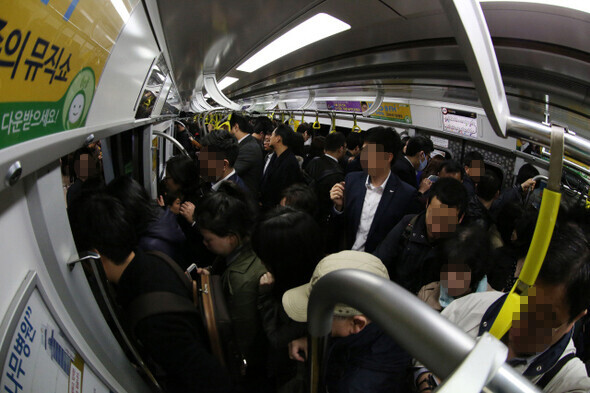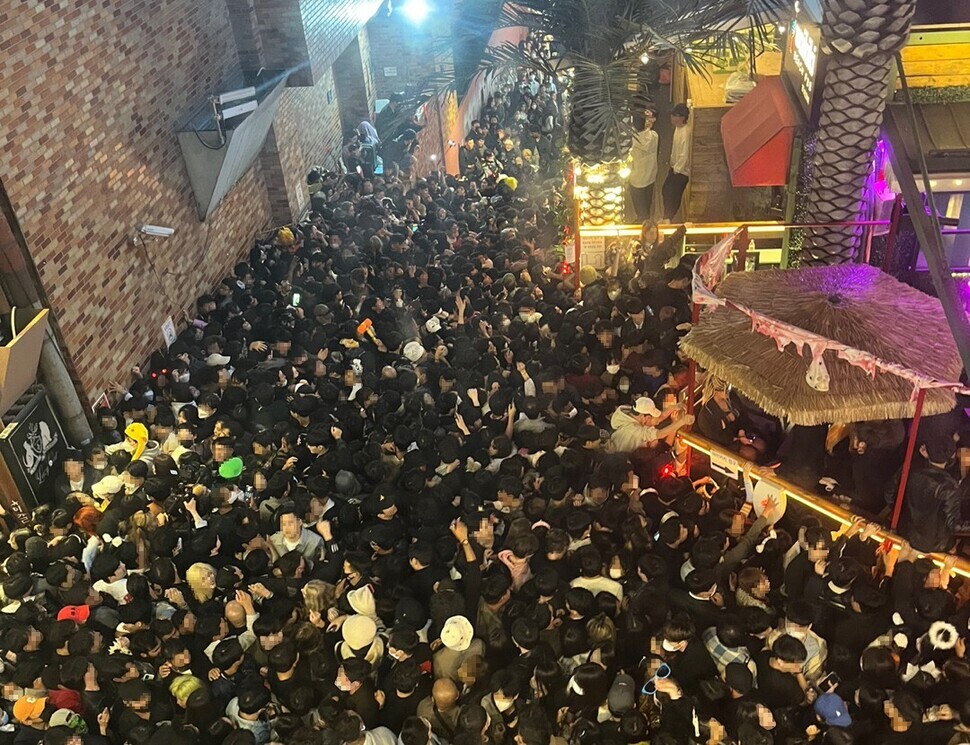hankyoreh
Links to other country sites 다른 나라 사이트 링크
Seoulites are used to overcrowding — that’s what makes it dangerous

In the wake of the Itaewon crush that took place Saturday night, an increasing number of people are being reminded of the daily dangers of being possibly crushed.
In Seoul, a city with a population of 9.5 million people, the term “overcrowded” has always been familiar. Now, however, the word has become synonymous with a daily danger that could be encountered at any time.
After what happened at Itaewon, the public has been increasingly calling for the government to analyze the overcrowded environment in the city and set up comprehensive measures. In addition, another important task will be for individual citizens to become more aware of the dangers of overcrowded environments.
“I take the subway’s Line 9 express train, which is crowded with people during rush hour, but after hearing the news of the accident at Itaewon, it was the first time I thought that I could actually be crushed to death,” says 31-year-old Lee Yoo-mi (a pseudonym), an office worker in Yeouido.
“Just like with elevators, it is necessary to put a limit on the number of passengers or weight in the subway," Lee added.
Kim So-hyeon (pseudonym, 30) also recalled her experience of not being able to breathe at a K-pop idol concert.
“I was watching the concert from the standing first row. Whenever the singer approached, I would be pushed from behind by the audience, which put pressure on my chest and made it difficult to breathe,” Kim said, adding that the chest pain continued even after the end of the concert.

While the population of Seoul has been declining, the capital city is still very overcrowded. According to the Korean Statistical Information Service, or KOSIS, as of last year, Seoul had a population of 9.5 million and a population density of 15,699 people per square kilometer.
This is almost four times that of Busan (4,320 people per square km), which is the city with the second-highest population density in the country.
According to City Mayors, a site that specializes in urban data research, as of 2018, the population density of Seoul (including Incheon) was the sixth largest in the world out of 300 cities ranked by population.
The cities ranked Nos. 1 to 5 were Mumbai and Kolkata in India, Karachi in Pakistan, Lagos in Nigeria, and Shenzhen in China, respectively.
In reality, becoming overly accustomed to an overcrowded environment poses a bigger risk than overcrowding itself.
In an interview with CNN on Sunday, former Assistant Secretary for US Homeland Security Juliette Kayyem, a disaster management expert, said that the fact that crowds are so common in Seoul may have played a role in the Itaewon crush.
“People in Seoul are used to being in packed spaces, it’s possible they might not have been fully alarmed by the packed streets,” she said, adding that "there is a danger of being too used to being in crowded spaces.”
Despite this reality, the government’s “manual” for how to respond to large crowds remains inadequate.
Although more than 100,000 people flocked to the Itaewon area, which has narrow alleyways on every slope, it turned out that the Seoul metropolitan government, Yongsan District Office, and the police all failed to take any special measures.
Yongsan District, the local municipality with jurisdiction over the Itaewon area, did not even come up with a safety management plan for the Halloween weekend. Similarly, the police only deployed 58 uniformed police officers to maintain public order.
“Neither the government nor the public felt it possible that people could be crushed to death in the middle of downtown Seoul, so safety measures have been poor for some time now,” says Lee Song-gyu, president of the Safety Professional Association of Korea.
“With what was learned through this accident, the government should come up with new measures to deal with overcrowded environments,” Lee said.
Hwang Seung-sik, professor at Seoul National University’s Graduate School of Public Health, also argues that the Itaewon crush could have been prevented.
“This accident could have been prevented if we had managed people’s movement such as by [enforcing] one-way traffic, and if we had put in place a plan beforehand for the Itaewon subway station stop to be skipped during rush hour,” Hwang says.
Some also point to the need to learn from measures taken by other countries that similarly suffered massive disasters due to crush accidents.
For instance, the UK enacted the Football Spectators Act in 1989 for safety management at soccer fields after a crowd was crushed at Hillsborough Stadium and a spectator who was trapped in a fence died.
The law calls for granting soccer clubs a license to control the admission of spectators and to decide who they allow in as well as for the establishment of a supervisory agency to manage these licenses. The law also called for getting rid of standing seats and made a proper seating system obligatory.
After repeated crush accidents took place during pilgrimages to Mecca, Saudi Arabia also announced the establishment of special countermeasures in 2016.
The time allowed for the actual pilgrimage was restricted and people were made to wear an electronic bracelet with a built-in GPS chip when entering the mosque.
Similarly, after the crushing accident in Akashi, Hyogo Prefecture in 2001 during a fireworks display, Japan amended the rules of the National Public Safety Commission and a security bill to add a “crowd security” clause to security operations.
Also, in Shanghai, China, an ordinance was enacted concerning the safety management of public places such as tourist destinations and parks after an accident took place in which 36 people were crushed to death by crowds during a New Year’s celebration in 2014.
The ordinance called for systematic information sharing among related agencies and the strengthening of on-site observation when large crowds gather.
Both domestic and foreign experts emphasize that “predicting” is more important than anything else to prevent accidents caused by overcrowding.
“Prevention and preparation are only possible if things are properly predicted,” Jeon Chan-ki, professor emeritus at Incheon National University emphasized.
Kim Tae-hwan, a professor at the department of security studies at Yong In University, also underscored the importance of different agencies working together to prevent accidents.
“In Japan, after the Akashi fireworks festival accident, even if there is no event organizer, the police, firefighters, and local government all work together to establish their own safety plan when crowds gather, such as on Christmas and Lunar New Year,” Kim explained.
“This year is not the first time that crowds have gathered for Halloween, but there were no countermeasures from the department in charge of disaster safety, such as the installation of dividers [to separate movement] or accident prevention measures,” Kim continued.
Some experts are also advising that citizens and institutions should have more awareness regarding the dangers of overcrowding.
"There are many safety devices in subways and concert halls, but people sometimes take dangerous risks either to go faster or because they want to enjoy the performance more,” says Lee Young-joo, a professor of fire and disaster prevention at the University of Seoul.
“Institutional supplementation is important, but citizens should also be aware of and prepared for dangers concerning overcrowded environments,” Lee added.
By Jeong Hye-min, staff reporter; Seo Hye-mi, staff reporter
Please direct questions or comments to [english@hani.co.kr]

Editorial・opinion
![[Column] Park Geun-hye déjà vu in Yoon Suk-yeol [Column] Park Geun-hye déjà vu in Yoon Suk-yeol](https://flexible.img.hani.co.kr/flexible/normal/500/300/imgdb/original/2024/0424/651713945113788.jpg) [Column] Park Geun-hye déjà vu in Yoon Suk-yeol
[Column] Park Geun-hye déjà vu in Yoon Suk-yeol![[Editorial] New weight of N. Korea’s nuclear threats makes dialogue all the more urgent [Editorial] New weight of N. Korea’s nuclear threats makes dialogue all the more urgent](https://flexible.img.hani.co.kr/flexible/normal/500/300/imgdb/original/2024/0424/7317139454662664.jpg) [Editorial] New weight of N. Korea’s nuclear threats makes dialogue all the more urgent
[Editorial] New weight of N. Korea’s nuclear threats makes dialogue all the more urgent- [Guest essay] The real reason Korea’s new right wants to dub Rhee a founding father
- [Column] ‘Choson’: Is it time we start referring to N. Korea in its own terms?
- [Editorial] Japan’s rewriting of history with Korea has gone too far
- [Column] The president’s questionable capacity for dialogue
- [Column] Are chaebol firms just pizza pies for families to divvy up as they please?
- [Column] Has Korea, too, crossed the Rubicon on China?
- [Correspondent’s column] In Japan’s alliance with US, echoes of its past alliances with UK
- [Editorial] Does Yoon think the Korean public is wrong?
Most viewed articles
- 1‘We must say no’: Seoul defense chief on Korean, USFK involvement in hypothetical Taiwan crisis
- 2Will NewJeans end up collateral damage in internal feud at K-pop juggernaut Hybe?
- 3[Column] Park Geun-hye déjà vu in Yoon Suk-yeol
- 4Why Korea shouldn’t welcome Japan’s newly beefed up defense cooperation with US
- 5Thursday to mark start of resignations by senior doctors amid standoff with government
- 6N. Korean hackers breached 10 defense contractors in South for months, police say
- 7[Guest essay] The real reason Korea’s new right wants to dub Rhee a founding father
- 8[Column] ‘Choson’: Is it time we start referring to N. Korea in its own terms?
- 9Kim Jong-un expressed ‘satisfaction’ with nuclear counterstrike drill directed at South
- 10[Editorial] New weight of N. Korea’s nuclear threats makes dialogue all the more urgent